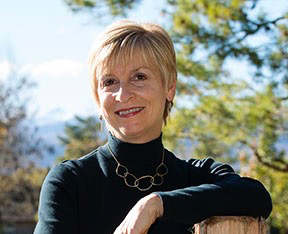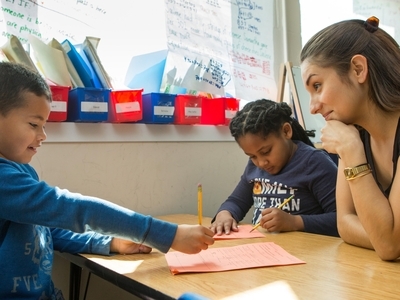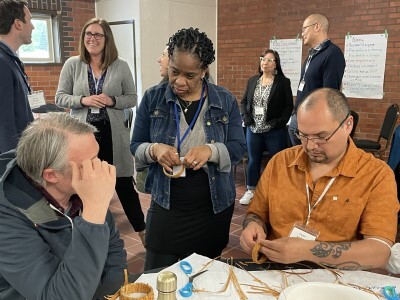Learning without Boundaries at Kettle Moraine School District
Topics
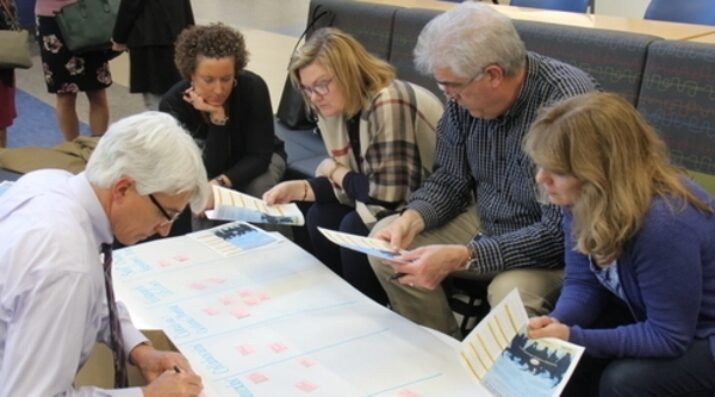
Next generation learning is all about everyone in the system—from students through teachers to policymakers—taking charge of their own learning, development, and work. That doesn’t happen by forcing change through mandates and compliance. It happens by creating the environment and the equity of opportunity for everyone in the system to do their best possible work.
Practitioner's Guide to Next Gen Learning
Putting students and educators at the center of their learning is at the heart of this Wisconsin school district's 15-year transformation journey.
It's not unusual for educators in the NGLC community to express a sense of urgency around transforming learning. Once stakeholders find their "why" for change, many seek to take action immediately. They ask each other—and us—how to create student learning right now that is powerful, equitable, and learner-centered, how to design learning that will prepare students for lifelong success. This bias toward action is a powerful force for change. It galvanizes a community, calls into question outmoded practices, and inspires innovative solutions to challenges. Like the starting gun for a 50-yard dash, it gets the adrenaline flowing for change.
For a long-distance run, however, adrenaline alone will only take you so far. Just as preparing for a marathon, compared to a sprint, requires new muscles and different kinds of training, learning transformation calls for new mindsets and approaches that will support continuous change over time. Much can be learned, then, from schools and districts that have taken bold action to transform student learning but at the same time have adopted new practices to sustain and refine their educational vision over the long haul.
This edition of Friday Focus: Practitioner's Guide to Next Gen Learning tells the story of the Kettle Moraine school district in southeast Wisconsin, a district that embarked on a journey to personalize learning in 2005. Recently featured as an exemplary Future Ready school district by the U.S. Department of Education, Kettle Moraine also serves as a partner and exemplar of effective change practices for NGLC's Next Gen Change Management Project. I spoke to Pat Deklotz, the district's superintendent, about what change looks like in Kettle Moraine schools and what they've learned, including:
- The skills and capabilities all learners need for lifelong success
- What personalized learning looks like for both students and educators
- What the Kettle Moraine school district has learned about change
A New Definition of Success
We've been talking about lifelong learners for as long as I've been in education; but now we are really helping students understand what lifelong learning is—it's the ambiguity of continuously growing, responding to what we experience, and contributing and making a difference.
–Pat Deklotz, superintendent of the Kettle Moraine school district
Like many schools and districts committed to transforming learning, the Kettle Moraine school system engaged the community to rethink traditional definitions of student success like graduation requirements. More and more, next gen educators and community stakeholders are creating broader and deeper graduate profiles by asking questions like these from Kettle Moraine's website: How do we define "well-educated" in the context of a new generation of learners in the 21st century? How do we deliver relevant learning opportunities that prepare all students for their future?
Asking such questions inspired the Kettle Moraine schools to create a new Graduate Profile, a definition of a successful graduate that focuses on competencies, like communication and critical thinking, and dispositions, like being a lifelong learner and engaged citizen. These capabilities transcend traditional notions of content-area knowledge. However, Pat emphasizes that they do not supplant academic learning.
"We do pay attention to standardized academic measures and growth," she says. "We are convinced that academics are important, but the dispositions in our graduate profile are actually more predictive of student success: knowing how to collaborate, be critical and creative thinkers, and articulate what they are learning, the passions they've discovered, and a sense of purpose for their work."
A key theme running through Kettle Moraine's work is that change is both constant and desirable. For example, the language in the district's Graduate Profile captures the mutable nature of modern life. The profile's aspirations for graduates include verbs like "innovate" and adjectives like "open-minded" and "adaptable," as well as phrases like "remaining flexible and open to new ideas" and "apply[ing] learning to new situations and challenges." Rather than presenting a static snapshot of skills of the moment, the Kettle Moraine Graduate Profile reflects a long view of continuous learning for success in a changing world.
In addition, perceiving change as natural and positive is central to Pat's way of thinking about education as a whole. As she explains, "One of the really powerful understandings that we've uncovered is that you will never arrive. Improvement is part of human nature. Improvement doesn't mean that you are not good; it means that you want to be better."
Many next gen educators, Pat included, refer to 20th-century approaches to education as "the factory model." However, she is quick to point out that, in its day, even the one-room schoolhouse was an innovation. "It was an answer to the challenge of equity, giving everyone access to learning," she explains. "The factory model was also an improvement on what came before because it supported learning in the content specialties. Now we understand more about what else students need. We have to keep changing because we can always do better."
Transformed Learning
It's not just students who need to learn without constraints, but also teachers and parents and the community.
–Pat Deklotz
Pat describes how, in 2005, the Kettle Moraine school board unanimously passed a motion to transform learning to meet the needs of all students. According to Pat, that board vision, summed up in the phrase "Learning Without Boundaries," was the catalyst for 15 years of transformation. However, she recalls, "How we would accomplish this was intentionally left open." Pat, then an assistant superintendent, and Bob Davidovich, the principal at Cushing Elementary School, were tapped to engage the community and lead the change.
"At the time, no one was doing personalized learning. We didn't even know what to call it," she says. However, Pat identifies a central question that guided their work: "How do we allow students to navigate who they are and what they want to do in their learning, instead of having it be something done to them?"
Today, the Kettle Moraine district's definition of personalized learning articulates a shared vision of a learner-centered and learner-driven educational experience. Key elements of Kettle Moraine's model include personalized learning plans, student-driven goals for learning, and choice in how students learn and demonstrate that learning. Technology tools can facilitate teaching and learning, for example, by providing real-time data to inform instruction. However, Pat explains, "When we talk about personalized learning, we don't just mean tech. We are talking more about the students' experience as learners. Digital tools support some of the rote processes in the classroom, so teachers can focus on deep learning."
As part of the U.S Department of Education Future Ready Initiative, launched in 2014, a film crew visited Kettle Moraine schools to document the district's practices around personalized learning. In this video (not available), for example, a student describes student-centered learning in Create House, a multiage learning environment at Kettle Moraine Middle School. Working in an open learning space with numerous seating and collaborating options, middle school students experience learning that is self-paced, passion-driven, and interdisciplinary. They also exercise choice over how they demonstrate their learning, from creating websites to museum exhibits to documentaries in areas of interest.
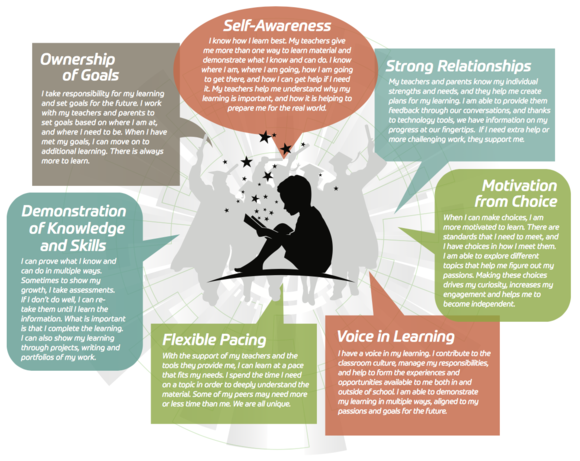
Personalized learning at the Kettle Moraine school district
Educator Empowerment and Efficacy
Make sure the adult process reflects what you want to do with kids—this is one of the significant differences we focus on. If teachers haven't experienced it, it's really hard for them to implement it.
–Pat Deklotz
According to Pat, transformation of student learning in the Kettle Moraine district began with voluntary pilot efforts and case studies as a way to "start work with the willing" among the district's schools and educators. However, she soon noticed a phenomenon unfolding: "Our early adopters were those who had experienced some form of personalized learning, but the teachers who were less eager were those who had not experienced personalized learning for themselves. They felt less empowered."
Responding to that insight, the district transformed educator professional learning so that it mirrored the kind of learning the schools provided to young learners. Like students, Kettle Moraine teachers experience a personalized approach. Pat describes the model as both very collaborative and "based on artifacts of learning, not seat time. Teachers have many routes and different ways of demonstrating what they've learned."
The cornerstone of this approach is micro-credentialing, a personalized, learner-centered practice that supports professional growth and provides teachers with increased compensation as a result of the credentials they earn. Educators propose topics of study, gather relevant research and resources, and lead face-to-face and virtual meetings in what Pat refers to as "a kind of professional learning community without walls."
For example, she describes a micro-credential in close reading that was designed by a group of literacy teachers. According to Pat, more than 40 educators signed up for it. "It was powerful because it met the needs of science teachers, history teachers, and others about supporting learners in reading the kinds of text they would encounter in the different courses. It helped educators learn about other disciplines but with the common goal of improving reading."
To demonstrate their learning to earn each micro-credential, educators collect and share artifacts like work samples, demonstrations, videos of students discussing their learning, and written reflections from both educators and learners. Pat observes, "As we implemented micro-credentials, teachers saw themselves as co-creators and professionals. They felt they had a voice in their work. Your teachers are your biggest resource, so we aligned that resource to the district goal—personalization."
Pat also highlights Kettle Moraine's distributed-leadership model, which includes new career pathways and redefined roles for educators. Unlike traditional career ladders, which require teachers to choose between teaching and administration, experienced Kettle Moraine educators can assume part-time leadership roles as directors of learning and learning coaches. These educator-leaders, she explains, take on supervision, mentoring, and professional-development roles while at the same time maintaining their credibility as classroom educators.
Advice From a Colleague
Although Pat is quick to say that the work is always evolving and never "done," she and her district are willing to share what they have discovered on their journey so far. "Number one," she says, "is to listen to students and reflect on what they are saying. Listen and then act on it. Their criticism is not intended to put us down but to help us improve."
Communication is a close second on her list. "Pay attention to how you share the work you are doing with your community. You can never, ever communicate enough. Think about using multiple modalities. Include face-to-face communication, but don't rely on that, especially when bringing in the community that is not directly involved in schools. With all of the digital tools, people can be very selective about how they access information." Communicating with the internal audience, especially learners, is also essential. To exercise choice and voice, she observes, "Students have to know what their choices are."
Last of all, she urges fellow educators to "go slow to go fast. Build in time for reflection and celebration of the work that you are doing. It's OK to take the foot off the gas sometimes and let people enjoy this rewarding work."
Resources
- These Future Ready videos and this Personalized Learning video, taken together, provide a virtual site visit to the Kettle Moraine school district and serve as a resource on collaborative leadership, personalized student learning, robust infrastructure, and personalized professional learning.
- KMSD's Personalized Learning "Look Fors" document presents a continuum of practices from curriculum-centered to learner-driven and was created to build understanding and inform goals as the district moves toward the vision of "personalized learning for all."
- The Kettle Moraine district's Graduate Profile articulates the school and community goals for student learning and future success.
- "The Student in the Center: Personalized Learning in Kettle Moraine" explains and illustrates the district's personalized approach to learning. (resource not available)
- This article on Transformation Science by NGLC director Andy Calkins features schools and districts, including Kettle Moraine, that are leaders in next gen change management.
Photo at top, courtesy of Kettle Moraine School District: Mike Comiskey, middle school principal; Laura Lloyd, middle school associate principal; and middle school educators Kay Staley, Mike Steger, and Sherie Drolshagen work with the KMSD Graduate Profile.

